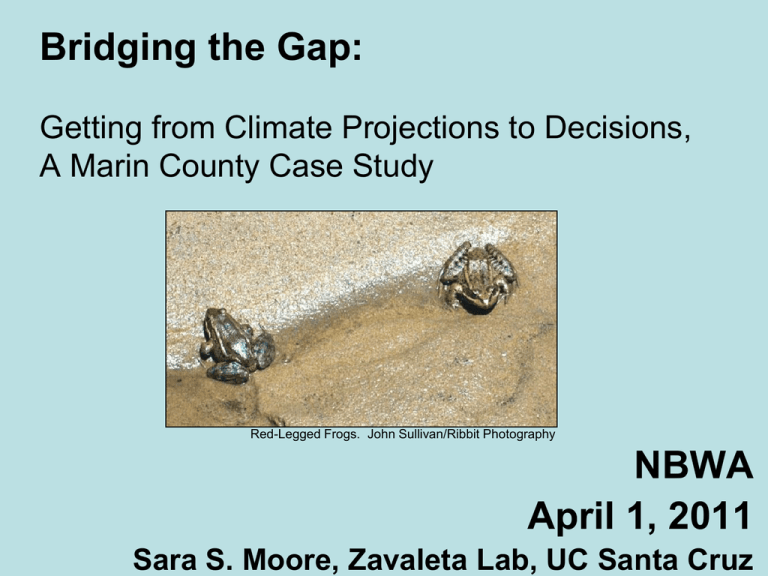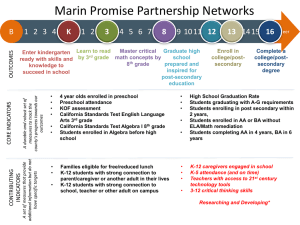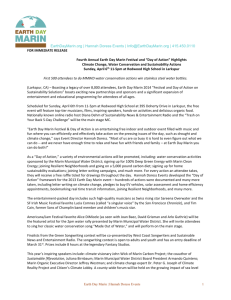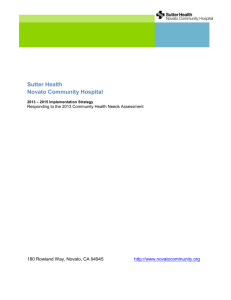Bridging the Gap
advertisement

Bridging the Gap: Getting from Climate Projections to Decisions, A Marin County Case Study Red-Legged Frogs. John Sullivan/Ribbit Photography NBWA April 1, 2011 Sara S. Moore, Zavaleta Lab, UC Santa Cruz Bridging the Gap: Getting from climate projections to decisions, a Marin County Case Study • • • • Background on adaptation The California study The Marin County case study Conclusion “Adaptation” consists of... • Actions to realize gains from opportunities or to reduce the damages that result from climate change. p. 11, Agrawala, S. & S. Fankhauser (Eds.) (2008). Economic Aspects of Adaptation to Climate Change: Costs, Benefits and Policy Instruments. Office of the Secretary-General of the Organisation for Economic Co-operation and Development (OECD). How is adaptation related to mitigation? • Mitigation is driving a Prius. • Adaptation is driving your Prius to higher ground. The Building Blocks of Climate Adaptation 1. Emergency Services 2. Safety Measures / Disaster Prevention 3. Protecting human systems Fire, flood, heat, storms 4. Protecting natural systems 5. Protecting clean air and water supply (forests, rivers, groundwater) 6. Mitigation of GHGs Impact planning horizon (near to long term) https://gnocdc.s3.amazonaws.com/maps/PDFs/vehicle_access.pd f You might need a car to get to safety Promoting healthy forests and urban green spaces reduces both GHGs and the impacts of climate change http://www.seedsdream.org/Volunteering.html “Co-benefits” “No Regrets” Adaptation Approach • Has benefits even in the absence of climate change. • Popular (cheap, OK for skeptics). • It looks a lot like business as usual. “Mainstreaming” Adaptation Approach • Climate change impacts considered within existing plans. • Theoretically the best way to prepare. • Tends to produce “no regrets” actions. • It looks a lot like business as usual. “Ecosystem-Based” Adaptation • Using natural systems as a basis for adaptation strategies. – Popular among resource mgrs. – Most natural– effective? Cost-effective? – More flexible than infrastructure – Example: wetlands v. sea wall. • Needs more research to sell it to politicians. “Top Down” v. “Bottom Up” Approaches • Describes where direction for action originates. Funding, Guidance, Coordination Pilot project feedback, Critical variables for decisions, Knowledge of local history of change What makes adaptation choices hard? •Uncertainty •Costs •Perception of “giving up” What is the state’s responsibility to the people of Pacifica? http://assets.knowledge.allianz.com/img/natural_disasters_dangerous_building_erod ing_cliffs_landslide_q_16958.jpg What do you do when people won’t move? Bridging the Gap: Getting from climate projections to decisions, a Marin County Case Study • • • • Background on adaptation The California study The Marin County case study Conclusion Global Vulnerability Map Global Climate-Demography Vulnerability Index (CDVI): Red = really bad Samson, et al. (2011) “Geographic disparities and moral hazards in the predicted impacts of climate change on human populations,” Global Ecology and Biogeography. California’s Climate Vulnerability http://conserveonline.org/workspaces/CA.climate.change/documents/california-climate-stress-reports/view.html - posted by Kirk Klausmeyer, TNC, 2009 http://www.popstarsplus.com/politicians_arnoldschwarzenegger.htm “Climate Vulnerability and Adaptation Study for California” How can we bridge the data-decision gap for resource managers? • Public natural resource management context • California case study • Using scenario planning (workshop, technical memo) • To support decision-making around the state Bridging the Gap: Getting from climate projections to decisions, a Marin County Case Study • • • • Background on adaptation The California study The Marin County case study Conclusion Case Study “Futures of Wild Marin” West Marin Protected Areas: Bolinas Lagoon, Muir Woods NM (GGNRA), Point Reyes NS, Marin Municipal Water District, Samuel P. Taylor and Mt. Tam SPs Collaborators, Informers • Erika Zavaleta, UCSC • Rebecca Shaw, TNC / EDF • NPS facilitators from the Global Business Network • Reps from 15 agencies invited to one day workshop on Jan. 28, 2011 • • • • • • • • • • Audubon Canyon Ranch Bolinas Community Public Utility District - BCPUD California Dept of Fish and Game California State Parks - Marin District Department of Water Resources - North Central Region Office Marin Agricultural Land Trust - MALT Marin County Fire Department Marin County Parks and Open Space Marin County Planning Department Marin Municipal Water District - MMWD Marin Resource Conservation District NPS / GGNRA Pepperwood Preserve Point Reyes Bird Observatory - PRBO Point Reyes NS http://img.geocaching.com/cache/83860819-e06c-44ff-be04-c68eaabcc438.jpg • • • • • Decision-making under climate uncertainty • “Ensemble” – Majority of available studies agree it will be warmer, drier, etc. • Scenario planning – Inevitabilities + uncertainties – Factors that put you in a new decision-making environment What are scenarios? Narratives outside the norm Multiple, plausible futures Not predictions: no probabilities attached Navigation tool to get past paralysis Pros and Cons of Scenarios Pro • Interactions, extremes, secondary impacts • Ideas, experience, management priorities drive the process (informed by science) • Action-oriented • Encourages broad, collaborative thinking • Gets past paralysis from not having all facts Con • Plausible futures = no more probable than climate model output Project Design 1.Select case study site 2. Create scenario development team August 2010: 13 sites considered Criteria for selection: – – – – – – High feasibility Has good climate data "Significant" to state Human & natural systems interact Land use types mixed Land management jurisdictions mixed 3. Develop scenarios – 100% within state (this excluded Lake Tahoe) – Minimally 1 sq. mile (not too small) – Mainly terrestrial – Includes State Parks Project Design 1.Select case study site 2. Create scenario development team 3. Develop scenarios October 2010: Team of 10 selected based on these criteria: – Work or worked in the case study site – Involved in long-term planning within their agency or organization – Consume or produce climate change data for decision-making – Available for 3 one hour phone calls in Nov., Dec., and Jan. + workshop Project Design 1.Select case study site 2. Create scenario development team 3. Develop scenarios Top Drivers of Change 1. Air temperature up. 2. Sea level up. 3. Seasonal extremes more prevalent. 4. Reduced biodiversity. Earlier More Easterly Same or lesser 1. Onset of Dry Season 2. Direction of Strong Wind 3. Capacity to Respond Later More Northerly Significantly greater Degree of Strong Wind Two Climatic Variables Societal Concern Direction of Nature Leadership Onset ofofDry Season The Climatic Scenarios Nature Leadership Onset ofofDry Season Cool Air, Dry Soil Landscapes less productive Disease and invasives curtailed Societal Concern Earlier Dry Season Degree of Warm Air, Dry Soil Loss of life due to wildfire Flood control deprioritized Water supply critically low Direction of Strong Wind More Easterly Wind More Northerly Wind Warm Air, Wet Soil New invasives become dominant, new diseases Erosion and flooding plus plant disease devastate farmers Later Dry Season Cool Air, Wet Soil Redwood population maintains well in refugia Erosion and flooding destroy coastal infrastructure “Fryin’ and Cryin’” • Defined by: – Earlier dry season, – Stronger easterlies, – Same/ less capacity • Headlines/ Events: – – – – – Big forest die-off on Mount Tam Lost wetlands, vernal pools State Parks lose funding Big fires we can’t fight ESA suspended, Coho locally extirpated • Top Actions: – Institutional coordination – Mandatory water rationing – Communication campaign/ volunteer science Common Definition of Adaptation by scenario development team Climate change 1. Maintain key ecosystem adaptation should: functions (to provide the 2. 3. benefits of nature to human populations); Facilitate a gentler transition under climate change, based on natural systems; Maintain bioregional native biodiversity. After Brainstorming Actions by Scenario: Criteria for Prioritization • • • • • Flexible/ robust to multiple scenarios Collaborative/ doesn’t duplicate efforts Uses adaptive management: uses monitoring, correct scale of design, best science, pilot programs, etc. Cost-effective/ sustainable Has clarity of design and transparency of implementation process Sample Priorities for Action Create a regional and collaborative approach to adaptation. Create a Ready-to-go Rapid Response Team – climate events, invasives, etc. Concrete Next Steps • Inter-agency Statement of Agreement on climate change adaptation for Marin County. • Downscaled climate vulnerability analysis for Marin County. • Integrate into state efforts. http://k41.pbase.com/g4/50/673150/2/61465176.DSC02201.jpg One Small Decision Bridging the Gap: Getting from climate projections to decisions, a Marin County Case Study • • • • Background on adaptation The California study The Marin County case study Conclusion Lessons Learned • • • • Keep it mixed: orgs, agencies Make geography smaller for specificity Attach to existing planning effort Science team: response to top variables before workshop • Webinar: impacts/ adaptation 101 • 2 days: (1) “certainties,” (2) “uncertainties” and scenarios • All participants select final variables Possible Next Site • Smaller scale within Marin County: Bolinas/ Stinson Beach (part of Our Coast- Our Future effort) – Resource managers, public utilities – DPW – Office of Emergency Services Thank you! Questions? Red-Legged Frogs. John Sullivan/Ribbit Photography Sara S. Moore - sasmoore@ucsc.edu Erika Zavaleta - zavaleta@ucsc.edu UC Santa Cruz/ Zavaleta Lab Environmental Studies Department University of California









